Elevating Stories and Spaces
An Interview with Sarah Crowell and Lauren Cox about SPACES: Oakland
BY EMMALY WIEDERHOLT
Sarah Crowell is a dance artist and teacher in Oakland, CA, who taught at Destiny Arts Center for 30 years, and Lauren Cox is a co-creator of SPACES, a choreographer, and a lecturer in Jazz Dance at UMass Amherst with roots in the Bay Area. They are choreographing the upcoming site-specific piece SPACES: Oakland, an immersive performance by Kaimera Productions that explores and celebrates public spaces through storytelling and contemporary dance. The first iteration of SPACES premiered in 2017 at the Mount Morris Ascension Presbyterian Church in Harlem, NY. Inspired by the success of that production, the team reimagined the project, adapting its form to any city, and soon after were invited by the Oakland/Saint-Denis Cooperation Project to create twin versions of the project for these two cities located on opposite sides of the world. Here, Sarah and Lauren share their involvement in the upcoming production of SPACES: Oakland and how they seek to elevate the people of Oakland and their stories through movement, ritual, and community.
SPACES: Oakland runs July 9-18 at Oakland City Hall. Ticket information is available here.
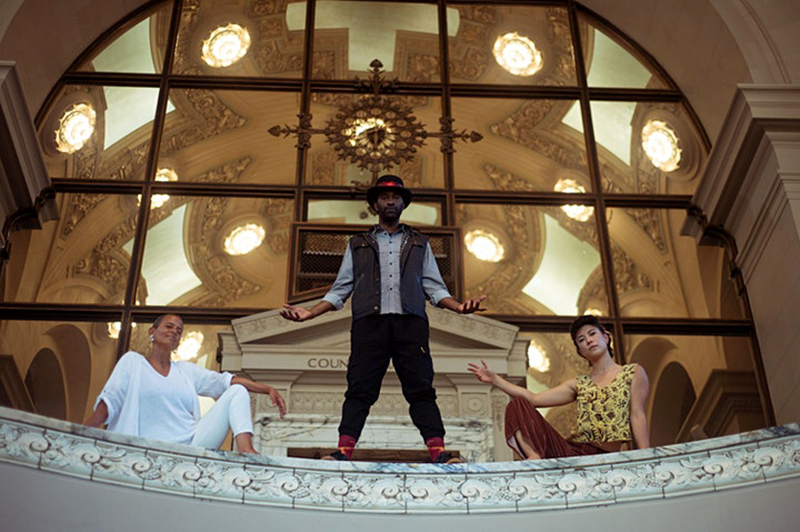
SPACES: Oakland dancers Sarah Crowell, Rashidi Omari & Rose Huey. Photo by Layeelah Muhammed.
~~
Can you tell me a little about yourselves and what has most shaped you as artists?
Lauren: I was born in San Francisco and raised in Marin County. I started as a rhythmic gymnast and did that from age six to 17. There were only three Black rhythmic gymnasts at the time in the entire country. That was what shaped my mentality in terms of work ethic, competitiveness, performance, and technique, which was contortion and flexibility. I loved performing; it was an outlet for my emotions.
I started training with Culture Shock Oakland and learned hip-hop from Nappytabs, Rhapsody James, and the Jabbawockeez, all of whom are now at the top of their game. I moved to Brazil for a year where I studied samba and learned Portuguese. I found my identity as a Black person in this world. That catapulted me into New York City. I spent 10 years in New York grinding, hustling, and learning jazz. I realized I had been doing jazz my entire life. And now I’m teaching at University of Massachusetts Amherst as a jazz lecturer.
Everything before that shaped me as a teacher and a dancer: working at Joffrey Ballet School and The Ailey School for several years, as well as doing many fun projects, giving a TED Talk, doing Off Broadway, even trying singing. I wanted to do everything so I didn’t regret anything. Now I feel really fulfilled as a choreographer and as a creator giving opportunity to others.
Sarah: I started training in ballet when I was five in Windsor, Ontario, Canada. I was obsessed with ballet and wanted to be a dancer. I was also the daughter of activists. My mother was African American and doing anti-racism work before it was called that. My dad was an ardent environmentalist. My mom moved our family to the West Indies. I found my Blackness in Naussau where I took ballet at an academy. My teacher had danced at Dance Theatre of Harlem, so I got my ballet on with Black people.
I moved to Boston and ended up dancing with Impulse Jazz Dance Company under Adrienne Hawkins. I loved jazz and became obsessed with that movement; it was ballet but it was funky, it was Black and it utilized my ballet technique. I moved out to the Bay Area chasing the Dance Brigade under Krissy Keefer. I had done a workshop with Dance Brigade in Boston and was like, “These are some gritty feminist fabulous people. I want to dance with them.” Magical story: I drove across the country with my girlfriend at the time and was in the company two weeks later. I danced with the company for eight years. Between my love of ballet, jazz, hip-hop, and social justice, all of that brought me to my work at Destiny Arts Center in arts education and development for 30 years.
I started the Destiny Arts Youth Performance Company in 1993. There were a couple documentary films made about the work I did. I didn’t really want to teach kids at first but after eight years I realized it was my calling. I always coach other teachers to lean into the work, lean into the tough parts, lean into the grittiness and beauty of teaching young people from the hood. I live five blocks from Destiny Arts Center and I became committed to this particular neighborhood and community.
I haven’t danced onstage for more than 15 years. I just recently left Destiny Arts Center. It had been 30 years and I turned 55.
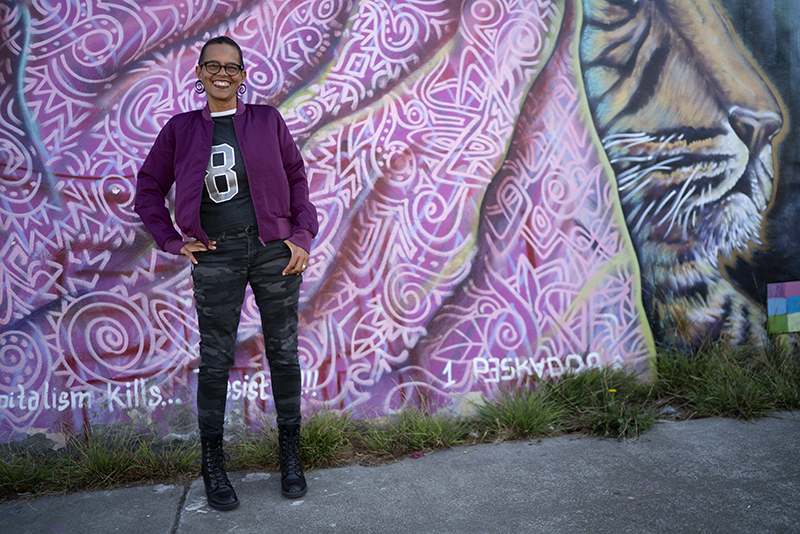
Sarah Crowell, photo by Kerry Kehoe
Lauren, I understand you were part of the first iteration of SPACES in Harlem. Can you share a little more about the idea behind SPACES and your experience of it?
Lauren: We were creating SPACES: Harlem just as Trump was getting inaugurated to office in 2017. It was a time of division, when everyone’s American-ness was being put into question. There was a general air of distrust and so we thought of storytelling as a medium with which to break through barriers. It’s very hard to hear someone’s story in a personal space and still hate them. We wanted to create something that would unify people within a given community in a time that told us to separate. With the commission from the Harlem Arts Festival, we were able to place a living and breathing museum of sorts into the Mount Morris Presbyterian Church that is central to Harlem. I was struck by Simón Hanukai, who is the artistic director of Kaimera Productions, and his decision to not “augment” the space but to really work with it. In the lower level of the church was a nursery with children’s paintings on the walls everywhere. It was a space that was very lived in. It was a profound experience to perform in this lived-in space and transform it. There were layers of projection that highlighted the history of Harlem on top of what is happening now.
The performance exemplified the diversity within the community. Harlem is experienced by so many Black people. But it is also very diverse, especially with the Latin American, Dominican, and Puerto Rican community, as well as gentrifiers. All these different elements exist together in this changing landscape, and that’s what we talked about in the storytelling. It was a wonderful homage and such a profound show that at the end we were encouraged by the Harlem Arts Festival producers and members of the audience to do it in other places.
Now it’s become more intentional about entering a community and supporting local residents in sharing their stories. We’re expanding SPACES to Oakland and Saint-Denis next. We’re exploring these similar cities in terms of international influences and marginalized communities. SPACES: Oakland is being developed parallel to SPACES: Saint-Denis as sister cities; we’ve been exchanging movement and conversations, and we’ll be including that movement in both shows. We’re learning from each other, decolonizing the museum, and entering these communities and really seeing them through past, present, and future and the people who are actually living in them.
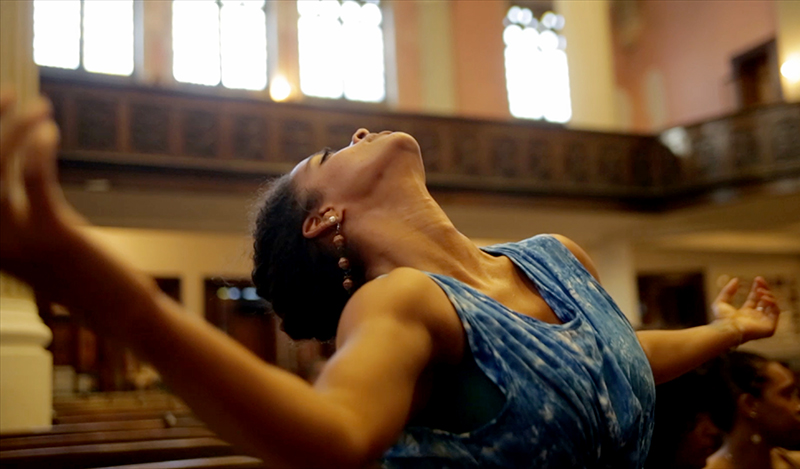
Lauren Cox in SPACES: Harlem. Photo by Dylan Lopez
Sarah, how did you get involved in SPACES: Oakland?
Sarah: Simón and I worked together at Destiny for six years. He was the co-artistic director of the teen company. He has been on a mission to get me to perform since that time. I finally was like, “Okay, I’ll do it.” I was really fascinated by the idea of site-specific work because I’m very much a proscenium producer. Besides the fact that the pandemic expanded so many people’s idea of what the stage was, I personally felt like I needed to stretch myself past my time at Destiny. I’ve been doing modern, salsa, and lay-around-on-the-floor improvisation the whole time I was working at Destiny, but Simón was badgering me to perform and we love working together.
It’s also a passion project for me because it’s about Oakland where I’ve lived for 30 years. I was able to bring folks who were born and bred into the team, like Rashidi Omari, who I co-directed Destiny’s teen company with for 11 years. Rashidi will be dancing along with two of our alums who are now professional performers. They are all born and bred in Oakland.
What are you putting together for the event and what has your work process looked like?
Sarah: It’s very collaborative in terms of how the movement is created. Lauren and Simón are the originators of the project, so they steer how things work in the space. I wouldn’t say there’s a choreographer so much as everyone giving their input.
Lauren: How it works is we enter the community and connect with storytellers who are very real people, like an aunt, the corner store man, a local star, people who are integral to the community. We put them in a historical location, in this case Oakland City Hall. And then we have four dancers who are the guides. We have an opening ceremony to welcome audience members to the space and bring everybody together to get the feel and movement of Oakland. Then each dancer leads a group of audience members to each one of the storytellers through movement. The group gets dropped off at a storyteller, and in the transitions is room to highlight historical contexts. We’ve been working with YR Media to come up with an Oakland playlist from the 1940s until now. Every transition is a decade of music and dance. We’re tapping into blues, Lindy Hop, rock n’ roll, jazz, R&B, hip-hop. At the end of the performance is a closing ceremony.
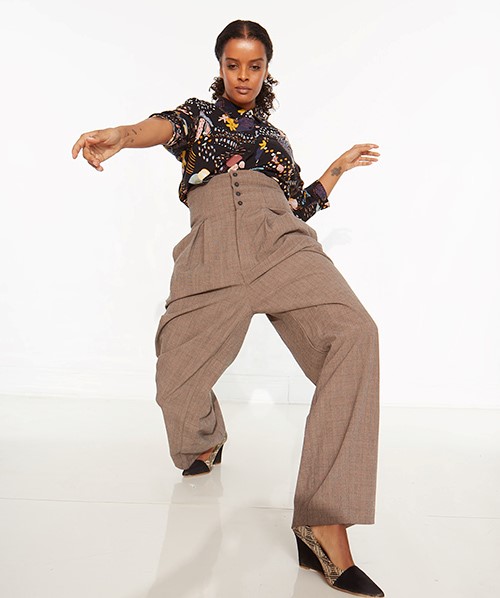
Lauren Cox, photo by Maria Panina
Stories move throughout communities in a really visceral way. SPACES highlights these stories and uses dancers as spirit guides to move through the past and the present.
In our process, we’ve talked a lot about archetypes. Each dancer has a color, and the audience members get a colored wristband that correlates with the dancer they’re following. We found relevance within the four dancers…
Sarah: Like the four directions, the four seasons…
Lauren: And from there it informed the movement.
Sarah: BANDALOOP, a vertical dance company (what used to be called an aerial dance company), is part of the finale. They will be doing vertical dance off City Hall. Audience members enter City Hall and are put into groups of 20 that are assigned to a dancer that coordinates with the color of their wristbands and our costumes. We open the ceremony on the stairs and then take them on a journey like Lauren was saying to hear different storytellers, and at the end we take them down the stairs and out into the amphitheater in front of City Hall, where there’s performance happening on the ground and in the air. The dancers are literally elevating the stories.
Lauren: By elevating these stories, we’re showing how we all exist in the same city and how our different stories can be melted together on many different levels. We’re making sure the aerial dance isn’t just a spectacle but is wrapped in the ritual of SPACES.
Sarah, since this is the first time you’ve performed in 15 years and also one of the first times dancers have been able to perform in-person since the pandemic started, do you have any reflections on what this means for you either personally or socially?
Sarah: It’s really interesting to be back in my body in this way. I surrendered my performance self for my teacher/administrator/director self. I performed for 15 years and it was satisfying. When people asked, “Do you miss performing?” I say no because I did it. Same with teaching; people ask if I miss teaching at Destiny but I did it for 30 years. I did them both thoroughly. But this feels like a new chapter. I’m getting back into my body in a different way and tapping back into my modern dance, ballet, and hip-hop.
There’s also this celebration of people coming together that I’m so honored that I get to be a part of. Maybe these folks have not been to a live performance in over a year, and I get to lay out a carpet for them and say, “Welcome home to your city.”
There are so many layers to it. I got married in San Francisco City Hall as a lesbian who wasn’t allowed to get married for a long time. I didn’t get married in Oakland because my partner was in San Francisco, but it was important to us to take public space. It’s important to take public space as artists, as queer people, as people of color. For me to be dancing in a rejuvenated way in a public space in a city that means so much to me is really powerful.
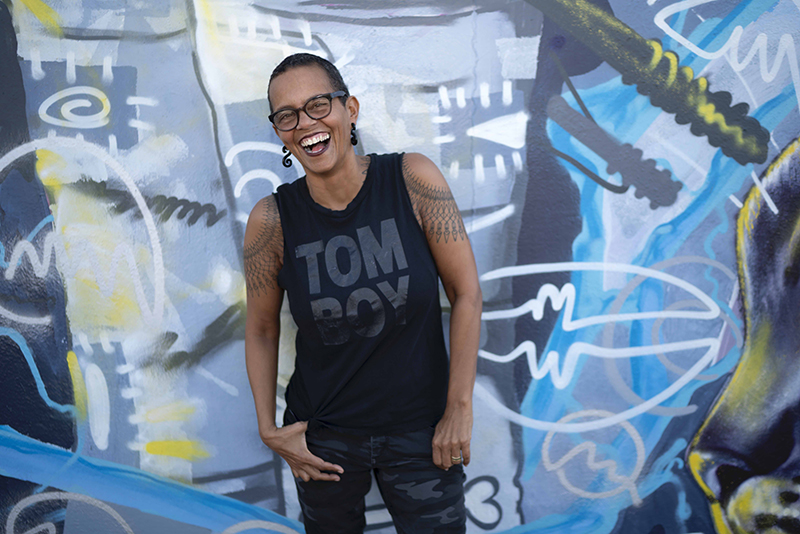
Sarah Crowell, photo Kerry Kehoe
What do you hope audiences take away from SPACES: Oakland?
Lauren: I hope audiences walk away knowing how important their own story is and that their voice is powerful. I want them to walk away inspired to create and think outside the box. Perhaps there’s something they’ve walked past five million times, and now maybe they notice something new. That’s what we’re working on in terms of highlighting this space. It’s a 360-degree experience, so I hope they walk away with a heightened level of awareness.
Sarah: If I would put it into one word, it would be “belonging.” We belong in our public spaces. We belong to each other. We belong in our city. We belong to our bodies.
Any other thoughts?
Lauren: We have some bad ass musicians we’re working with. One musician, Mena Ramos, concocted this drum ensemble that has three different sounds. Then we have Christelle Durandy, of Reunion Island and French West Indies ancestry who has roots in the Bay Area and Oakland and who sings about orisha worship. And then we have a live DJ, Dion Decibels, who is going to be mixing as well. Another brilliant thing Simón can do is bring many collaborators together and make it work. Everyone is completely bad ass and adds to the energy of the performance. It’s a wonderful experience to collaborate in and witness.
Sarah: And mad props to the folks at City Hall who have been working with us throughout the pandemic following COVID protocols and allowing us to be in the space.
~~
To learn more, visit www.kaimeraproductions.com/spaces-oakland.
Sarah Crowell has taught dance, theater, and violence prevention for more than 30 years. She just recently left her position as the artistic director at Destiny Arts Center in Oakland, CA where she served in different capacities from 1990-2020, including executive director from 2002-2007. She founded and directed the Destiny Arts Youth Performance Company from 1993-2020, which has been the subject of two documentary films and won the National Arts & Humanities Youth Program Award. Sarah has facilitated arts integration, violence prevention, cultural humility, and team building professional development sessions with artists and educators since 2000, both locally and nationally. She is also a retired professional dancer, having performed and toured with Impulse Jazz Dance Company in Boston and the Dance Brigade in San Francisco. She co-created the dance/theater company i am Productions!
Lauren Cox is a lecturer in Jazz Dance at the University of Massachusetts Amherst. Her personal research has led to collaborations with Joffrey Ballet School, The Ailey School, and José Limón Dance Foundation, as well as in Trinidad & Tobago, India, Hong Kong, Spain, Bolivia, Brazil, Ecuador, Colombia, France, Canada, and Mozambique. Lauren’s performance credits include Saturday Night Live, Black Girls Rock with Alicia Keys, Gwen Stefani, Coldplay, Pharrell, and Off-Broadway productions such as Seeing You and Hatuey: Memory of Fire. She has appeared in commercials for Samsung, Apple, and NYU Langone. Her work has been commissioned by TEDx Asbury Park, Columbia University, Hunter College, Berkeley Rep, and La Jolla Playhouse. Her poetry has been featured in Vogue Magazine and she has produced several showcases benefitting NYC dance and storytelling including the ongoing Stories from the Basement.
